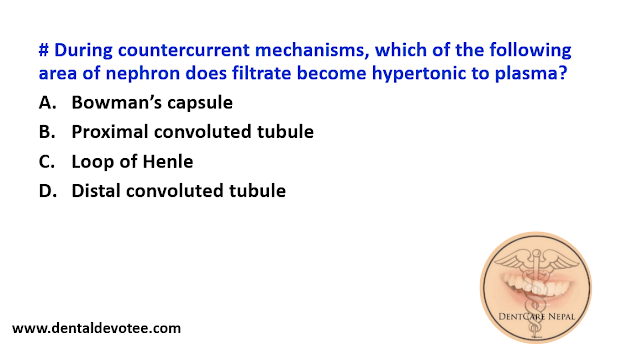A. Allergic conditions
B. Anemia
C. Polycythemia
D. Typhoid fever
# The number of walls in the apical portion of the defect is often greater than that of its occlusal portion, it is referred to as:
A. Osseous craters
B. Combined osseous defect
C. Horizontal defect
D. Vertical defect
# In marasmus, wasting is due to:
A. Prolonged dietary deficiency of calories
B. Prolonged dietary deficiency of Protein
C. Excess catabolism of fat and muscle mass to provide energy
D. All of the above
# Hyperparathyroidism is associated with:
A. Renal stones
B. Bone resorption
C. Increased level of serum calcium
D. All of the above
# Normal body mass index is between:
A. 16.5-20.5
B. 18.5-24.9
C. 25.0-29.9
D. 30.0-39.9
# Speed at which electrons travel in gas tube once released from cathode filament is dependent on:
A. Potential difference between electrodes
B. Angle between filament and andoic target
C. Amount of kilovoltage applied to the circuit
D. Intensity of current applied to the target
# Most common cause of cerebrovascular accident:
A. Arterial thrombosis
B. Venous thrombosis
C. Embolism
D. Tumor
# Which one of the following is the precursor of both gonadal and adrenocortical hormones?
A. Progesterone
B. Cortisol
C. Testosterone
D. Corticosterone
# Gingival manifestation is seen maximum with:
A. AML
B. CLL
C. CML
D. ALL
# A material like amalgam with high compressive strength but low tensile strength is said to be having:
A. Toughness
B. Brittleness
C. Ductility
D. Malleability
# Immediate management of tension pneumothorax is:
A. Tracheostomy
B. CT thorax
C. Central venous line access
D. Decompression with needle or chest tube
# Platelets adhere to the subendothelial collagen through one of the following:
A. Platelet factor 4
B. Fibronectin
C. Von Willebrand's factor
D. None of the above
# Most abundant immunoglobulin is:
A. IgG
B. IgM
C. IgD
D. IgA
# Dilatation of the pupil in head injury is due to:
A. Cerebral irritation
B. Compression of III cranial nerve
C. Pontine hemorrhage
D. All of the above
# Most common cause of thyrotoxicosis is:
A. Grave's disease
B. Multinodular goiter
C. TSH secreting pituitary tumor
D. Toxic adenoma
# Drugs producing ototoxicity and nephrotoxicity are:
A. Tetracyclines
B. Aminoglycosides
C. Quinolones
D. Macrolides



























